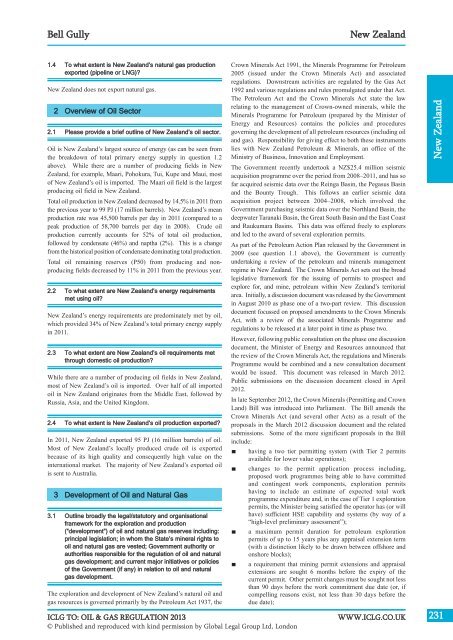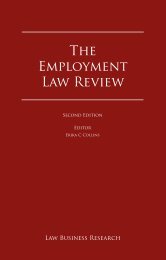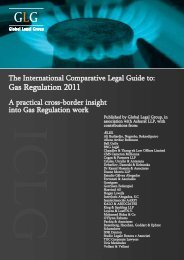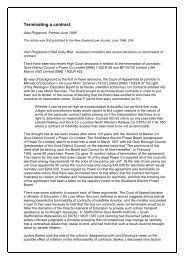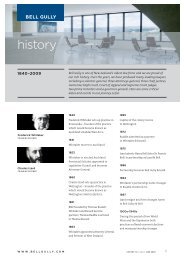Oil & Gas Regulation 2013
NZ Oil & Gas Chapter - The International Comparative ... - Bell Gully
NZ Oil & Gas Chapter - The International Comparative ... - Bell Gully
Create successful ePaper yourself
Turn your PDF publications into a flip-book with our unique Google optimized e-Paper software.
Bell Gully<br />
New Zealand<br />
1.4 To what extent is New Zealand’s natural gas production<br />
exported (pipeline or LNG)?<br />
New Zealand does not export natural gas.<br />
2 Overview of <strong>Oil</strong> Sector<br />
2.1 Please provide a brief outline of New Zealand’s oil sector.<br />
<strong>Oil</strong> is New Zealand’s largest source of energy (as can be seen from<br />
the breakdown of total primary energy supply in question 1.2<br />
above). While there are a number of producing fields in New<br />
Zealand, for example, Maari, Pohokura, Tui, Kupe and Maui, most<br />
of New Zealand’s oil is imported. The Maari oil field is the largest<br />
producing oil field in New Zealand.<br />
Total oil production in New Zealand decreased by 14.5% in 2011 from<br />
the previous year to 99 PJ (17 million barrels). New Zealand’s mean<br />
production rate was 45,500 barrels per day in 2011 (compared to a<br />
peak production of 58,700 barrels per day in 2008). Crude oil<br />
production currently accounts for 52% of total oil production,<br />
followed by condensate (46%) and naptha (2%). This is a change<br />
from the historical position of condensate dominating total production.<br />
Total oil remaining reserves (P50) from producing and nonproducing<br />
fields decreased by 11% in 2011 from the previous year.<br />
2.2 To what extent are New Zealand’s energy requirements<br />
met using oil?<br />
New Zealand’s energy requirements are predominately met by oil,<br />
which provided 34% of New Zealand’s total primary energy supply<br />
in 2011.<br />
2.3 To what extent are New Zealand’s oil requirements met<br />
through domestic oil production?<br />
While there are a number of producing oil fields in New Zealand,<br />
most of New Zealand’s oil is imported. Over half of all imported<br />
oil in New Zealand originates from the Middle East, followed by<br />
Russia, Asia, and the United Kingdom.<br />
2.4 To what extent is New Zealand’s oil production exported?<br />
In 2011, New Zealand exported 95 PJ (16 million barrels) of oil.<br />
Most of New Zealand’s locally produced crude oil is exported<br />
because of its high quality and consequently high value on the<br />
international market. The majority of New Zealand’s exported oil<br />
is sent to Australia.<br />
3 Development of <strong>Oil</strong> and Natural <strong>Gas</strong><br />
3.1 Outline broadly the legal/statutory and organisational<br />
framework for the exploration and production<br />
(“development”) of oil and natural gas reserves including:<br />
principal legislation; in whom the State’s mineral rights to<br />
oil and natural gas are vested; Government authority or<br />
authorities responsible for the regulation of oil and natural<br />
gas development; and current major initiatives or policies<br />
of the Government (if any) in relation to oil and natural<br />
gas development.<br />
The exploration and development of New Zealand’s natural oil and<br />
gas resources is governed primarily by the Petroleum Act 1937, the<br />
Crown Minerals Act 1991, the Minerals Programme for Petroleum<br />
2005 (issued under the Crown Minerals Act) and associated<br />
regulations. Downstream activities are regulated by the <strong>Gas</strong> Act<br />
1992 and various regulations and rules promulgated under that Act.<br />
The Petroleum Act and the Crown Minerals Act state the law<br />
relating to the management of Crown-owned minerals, while the<br />
Minerals Programme for Petroleum (prepared by the Minister of<br />
Energy and Resources) contains the policies and procedures<br />
governing the development of all petroleum resources (including oil<br />
and gas). Responsibility for giving effect to both these instruments<br />
lies with New Zealand Petroleum & Minerals, an office of the<br />
Ministry of Business, Innovation and Employment.<br />
The Government recently undertook a NZ$25.4 million seismic<br />
acquisition programme over the period from 2008–2011, and has so<br />
far acquired seismic data over the Reinga Basin, the Pegasus Basin<br />
and the Bounty Trough. This follows an earlier seismic data<br />
acquisition project between 2004–2008, which involved the<br />
Government purchasing seismic data over the Northland Basin, the<br />
deepwater Taranaki Basin, the Great South Basin and the East Coast<br />
and Raukumara Basins. This data was offered freely to explorers<br />
and led to the award of several exploration permits.<br />
As part of the Petroleum Action Plan released by the Government in<br />
2009 (see question 1.1 above), the Government is currently<br />
undertaking a review of the petroleum and minerals management<br />
regime in New Zealand. The Crown Minerals Act sets out the broad<br />
legislative framework for the issuing of permits to prospect and<br />
explore for, and mine, petroleum within New Zealand’s territorial<br />
area. Initially, a discussion document was released by the Government<br />
in August 2010 as phase one of a two-part review. This discussion<br />
document focussed on proposed amendments to the Crown Minerals<br />
Act, with a review of the associated Minerals Programme and<br />
regulations to be released at a later point in time as phase two.<br />
However, following public consultation on the phase one discussion<br />
document, the Minister of Energy and Resources announced that<br />
the review of the Crown Minerals Act, the regulations and Minerals<br />
Programme would be combined and a new consultation document<br />
would be issued. This document was released in March 2012.<br />
Public submissions on the discussion document closed in April<br />
2012.<br />
In late September 2012, the Crown Minerals (Permitting and Crown<br />
Land) Bill was introduced into Parliament. The Bill amends the<br />
Crown Minerals Act (and several other Acts) as a result of the<br />
proposals in the March 2012 discussion document and the related<br />
submissions. Some of the more significant proposals in the Bill<br />
include:<br />
having a two tier permitting system (with Tier 2 permits<br />
available for lower value operations);<br />
changes to the permit application process including,<br />
proposed work programmes being able to have committed<br />
and contingent work components, exploration permits<br />
having to include an estimate of expected total work<br />
programme expenditure and, in the case of Tier 1 exploration<br />
permits, the Minister being satisfied the operator has (or will<br />
have) sufficient HSE capability and systems (by way of a<br />
“high-level preliminary assessment”);<br />
a maximum permit duration for petroleum exploration<br />
permits of up to 15 years plus any appraisal extension term<br />
(with a distinction likely to be drawn between offshore and<br />
onshore blocks);<br />
a requirement that mining permit extensions and appraisal<br />
extensions are sought 6 months before the expiry of the<br />
current permit. Other permit changes must be sought not less<br />
than 90 days before the work commitment due date (or, if<br />
compelling reasons exist, not less than 30 days before the<br />
due date);<br />
ICLG TO: OIL & GAS REGULATION <strong>2013</strong> WWW.ICLG.CO.UK 231<br />
© Published and reproduced with kind permission by Global Legal Group Ltd, London<br />
New Zealand


